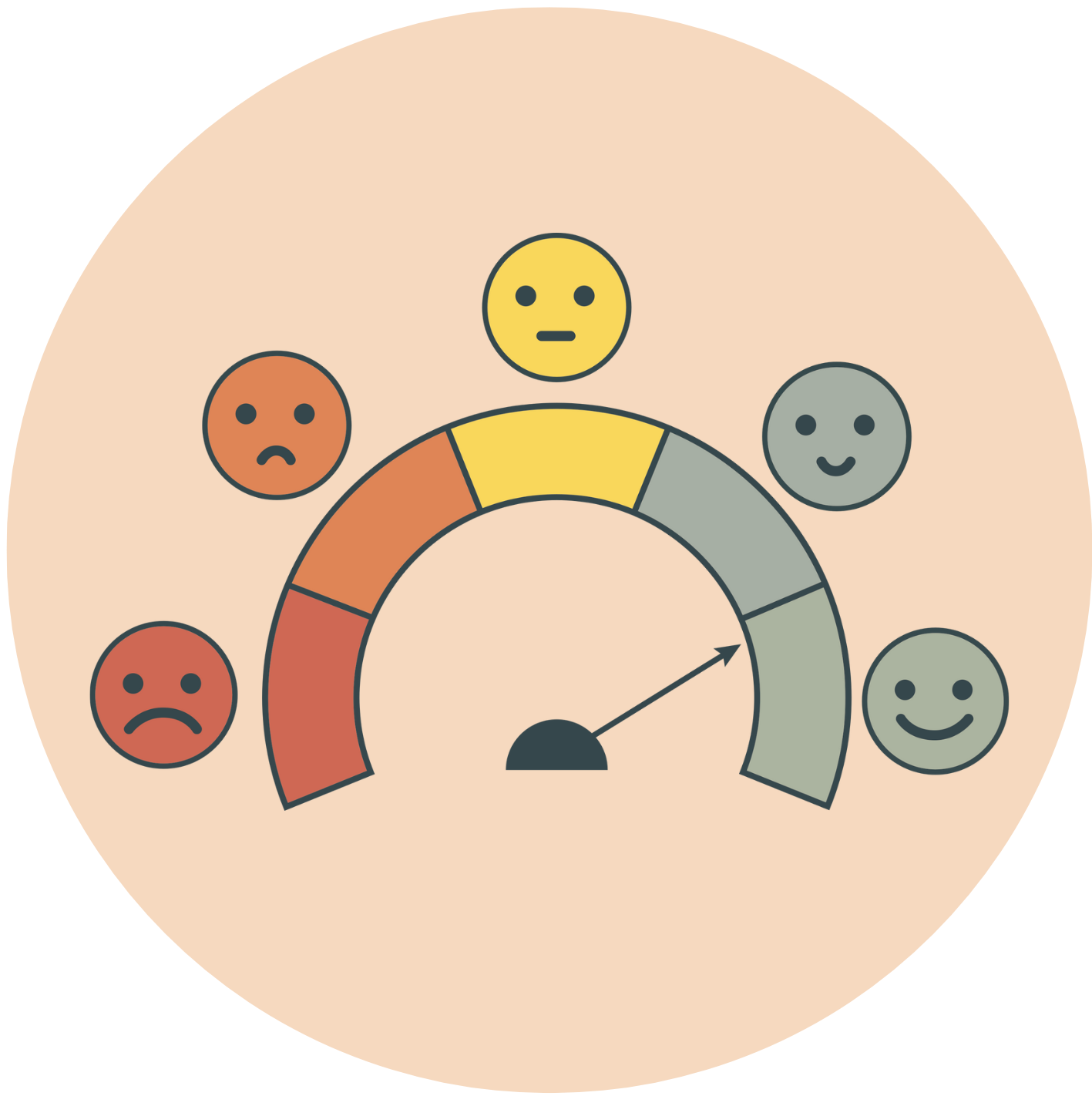How To Help Your Toddler with Emotional Regulation
This article contains affiliate links.
Jump to Toddler Emotional Regulation Must Haves ListYour toddler screams and collapses on the floor because you won’t let them play with permanent markers. It’s the fourth time this afternoon they've had a full-blown meltdown about something so…irrational. “Can you just chill out?” you shout. It’s not that big of a deal!”
We’ve all been there as moms. Sometimes, I feel like my daughter’s big feelings will make me absolutely lose my mind. I get overstimulated easily and have struggled to navigate the world of toddler emotions. It's too bad we aren't given a "big little feelings guide" when becoming a mom.Learning how to properly address our children’s emotions not only helps decrease our stress levels but also sets up our children for better relationships and happiness in life. They need us to guide them through the difficulties of emotional regulation instead of teaching them to bury their feelings.
“Children aren’t giving you a hard time, children are having a hard time.”
In this blog, I will expound on healthy (and realistic) tactics to manage toddler emotions based on research and respected childhood development professionals.
The three steps to helping your toddler emotionally regulate include:
Why is it essential for toddler parents to implement emotional regulation strategies?
How to address “big feelings” with your child.
How to take care of yourself while teaching emotional regulation.
Remember, you won’t always get this right. You are only human and doing your very best. The more you educate and arm yourself for battle, the easier it is to respond as your best self. One: Why is emotional regulation important for toddlers?
Imagine if the next time you are upset, someone comes up to you and says, “You need to just calm down…you’re being dramatic.” I bet that would only make you feel worse. This is how our kids feel when we dismiss them and tell them to chill out. It’s hard to remember this when our adult problems feel much more complicated and consequential than theirs. But when you’re three years old, not having fruit snacks before dinner feels quite devastating.
As parents, we must equip our children with emotional regulation abilities so that they can expand on this skill later in life. We don’t want our kids growing up to be those adults who go to level 10 when their pizza order is wrong. Or worse, the adults who continually struggle and suffer (and harm) relationally. Many people (especially in the past) believe a parent's job is teaching your child to “control their emotions.” The more progressive and enlightened perspective is that stuffing feelings only leads to more issues later down the line (depression, anger issues).
“Your job is NOT to change your child’s emotions. Your job IS to help your child learn to manage their emotions”
If we want our kids to grow up to be happy and emotionally mature humans, we have to implement strategies with this goal in mind. This is hard for anyone but especially daunting if we weren’t taught emotional regulation growing up. Luckily, there are surprisingly simple ways to address big feelings.
Two: HOW TO ADDRESS BIG FEELINGS
So, how do we teach an unreasonable toddler skills that many adults haven’t mastered? To put it simply, we educate, empathize, and calm down.
Continue reading to learn about the three steps toward emotional health for your child.
One. EDUCATE YOUR TODDLER ON WHAT EMOTIONS ARE
Before we can expect them to express their feelings constructively, we need to give them an age-appropriate understanding of what emotions are.
They’ve heard of “happy” and “sad,” but what about “frustrated, embarrassed, excited, and impatient?” Also, what does having that emotion actually feel like? Thinking about this helps them identify that emotion when it shows up in the future. There are so many amazing resources these days designed to educate young kids on emotions and what they feel like.
Here are a few of my favorites:
A Kids Book About…Series: Books by AKidsCo are perfect for educating children about complex topics in an age-appropriate way. They create empowering kids' books covering truly diverse and unique topics.
Mad, Mad, Mad, by Leslie Patricelli: This board book is written for children ages 1-3 and demonstrates what anger feels like in a very simplistic way. My daughter loves this book and has read it for years. I credit this book and other Leslie Patricelli board books as one of the reasons she is so great at expressing her feelings.
My First Book of Emotions for Toddlers, by Orlena Kerek MD: This picture book is designed specifically to introduce toddlers to emotions and the bodily sensations they bring.
“Children will listen to you after they feel listened to.”
TWO. VALIDATE THEIR EMOTIONS
Now that your child has a foundation to build on, you can move on to managing emotions. The primary strategy involves validation. Validating your little one’s feelings accomplishes multiple things, such as informing them emotions are okay (and not shameful) and demonstrating emotional self-awareness.
For example, if your child is having an emotional meltdown because you said it's time for bed, you would say, "I'm noticing you're angry about putting your toys down and getting ready for bed. It's okay to feel upset."These two sentences identify the emotion they may be feeling and give them permission to feel it without judgment. You may be thinking this sounds great, but how do you correct their wrong behavior that usually follows the big emotion? After validating their feelings, it’s completely okay to then set a boundary. In fact, it’s our job as parents to do so.
After your toddler screams about going to bed, they start to pick up their toys and hurl them at you. You take a deep breath and validate their feelings; then, you set a boundary. You say, "You cannot throw toys at me. You can be angry, but you can't throw things when you're angry. Instead, can you talk to me about how you're feeling?"When you finish correcting the wrong action (if there is one), you can continue to the calming step to help them regulate all the difficult feelings. Before we move on, if you’d like to dive more into this parenting strategy, here is an empowering book you may enjoy written by emotional development experts. I also really enjoy Dr. Siggie Cohen’s content on Instagram and her website. She has lots of free resources if you’re not looking to spend on this right now.
“When little people are overwhelmed by big emotions, it’s our job to share our calm. Not join their chaos.”
Three. USE EMOTIONALLY CALMING EXERCISES
This step is essential because no amount of education on emotions and validation will bring your toddler to a calmer, more regulated place. My favorite strategy for emotion processing is creating “a calming corner.”
A calming corner is a designated space for your child to slow down and engage in activities designed to regulate emotions. Prepare a basket with all your calming tools and exercises, and bring it to your “calming space.” You don’t necessarily need to designate one space, but it creates ease for you and consistency for them. You can also simply invest in tools that you only pull out when your kiddo is in need of an emotional reset.
Here are some of the absolute best calming corner must-haves:
The Feelings Activity Book for Toddlers: This book includes 50 fun activities for managing little feelings.
Feelings Vocabulary Poster: This chart divides emotions into 6 categories and offers a wide variety of words to pinpoint complex emotions. It actually reminds me of the feelings chart my couples therapist has given my husband and me. They also offer a feelings wheel with a similar concept.
What to Do When You Feel Like Hitting: This is a cute book for toddlers that offers alternative solutions to hitting in a positive and encouraging way.
What Zone Are You In? This emotions chart divides feelings into 4 main categories: blue, green, yellow, and red. This poster allows toddlers to explore their emotions without having to limit them to one finite word.
A Little SPOT of Emotion 8 Book Box Set: This set of 8 books is widely loved and offers fun and engaging content for all core emotions.
Storypod The Learning-First Audio Play System: This is an award-winning multi-sensory learning system that your child can engage with completely independently. My daughter has one, and she uses it independently with no issue. This may be one of my favorite solutions because all it requires is to lay back and listen. The content is created specifically to engage with children’s imaginations hands-free.
Even better, right now, they are releasing content on emotions! So far, my daughter has the scared, excited, and mad monsters, and she loves them.Sensory Bottles: This bundle includes 4 sensory bottles (each one representing a different emotion) created to help kids slow down and focus.
Calming Corner Posters: Decorate your space with calming directives for your toddler. This cute poster set includes grounding and breathing exercises, coping tools, and emotional check-ins.
It’s Okay to Feel Throw Pillow: This cute pillow is a great thing to casually display in your house in order to indirectly educate and normalize emotions.
Cozy Toddler Furniture: Complete the space with calming and comfy chairs and blankets to make them feel extra safe.
“Children are allowed to make a big deal out of things that feel really big to them”
Three: How to take care of yourself
Now, what about you, Mama? Coping with toddler emotions is a lot for us, too. If we don’t equip ourselves and create ways to destress, we will start to lose it. You do so much. The fact that you’re even here trying to implement new things to better your kid’s life says so much. You deserve to take care of yourself, too.
Continue reading if you’d like to learn strategies to mentally cope with your child’s big emotions and recommendations for your well-deserved self-care time.
ONE. SELF-REFLECT
When your child is having a tantrum in the middle of the store because you won’t buy the toy they want, what’s going on emotionally for you? Does it bring up feelings of guilt or worry that you’re spoiling your child? Maybe childhood trauma resurfaces as you remember never getting what you wanted growing up since your family didn’t have the money.
We may not recognize these hidden emotions within ourselves, but as we practice self-reflection (especially concerning our kids), they become more apparent. Whether you’ve never prioritized the skill of emotional regulation or you think about it regularly, learning to process emotions as a mom in a chaotic and overstimulating environment is very challenging.
Ask yourself, “Do I often feel emotionally triggered? Especially when it comes to my kid(s)?” Take time to reflect on moments you’ve felt upset lately. Is there a common theme? Is there a time when you’ve felt that way before? If you think you have triggers that need to be explored, I encourage you to dig deeper.
The first and most obvious option is to consider therapy. Maybe you’ve done therapy before, or therapy is a foreign concept. Either way, you deserve time to process your inner world and heal from traumas. Visit Psychology Today to find a therapist who fits your needs. I prefer virtual therapy sessions because they fit into my busy and unpredictable schedule as a mom.
Another (more accessible) option is to seek wisdom from mental health professionals regarding parenting and the complex emotional journey it brings. Here are a few resources I recommend:
Raising Good Humans, by Hunter Clarke-Fields MSAE: a compassionately written guide for parents to break the cycle of reactive parenting
Why Has Nobody Told Me This Before? By Dr. Julie Smith: an award-winning handbook written by a therapist to help navigate everyday emotional challenges such as anxiety, self-criticism, self-confidence, and motivation.
Permission to Feel, by Marc Brackett, Ph.D.: Permission to Feel, is a book on emotional intelligence that provides a scientific 5-step guide to dismantling the shame associated with feelings.
Anger Management for Parents, by Vivian Foster: a bestseller on understanding triggers and managing emotions that come with them.
Lastly, when doing a little self-reflection, whether post-therapy or while reading a good book, don’t forget to journal. The worst feeling is when you have an important insight, and you can’t remember it by the next day.
“Being a mother is learning about strengths you didn’t know you had, and dealing with fears you didn’t know existed.”
TWO. TAKE CARE OF YOUR MENTAL HEALTH
We’ve all heard the saying that you can’t pour from an empty cup. As a mom, I feel that this truth can be inconvenient sometimes. Of course, I’d love to engage in daily self-care, but who has time or energy for that?Whether we like it or not, the more we regularly neglect our needs, the more draining and challenging life as a mom becomes. Avoiding the upkeep of our mental health is counterproductive to our goals of being a good mom. You may feel like you’re in survival mode most of the time, and face masks and bubble baths sound like another chore. I get that.
For one, I’ve discovered many “self-care” activities that are far more satisfying than face masks (unless that’s your thing), and I’ll share some ideas with you below. Secondly, even taking just an hour before bed to do something that nourishes you can make a world of difference.“Sometimes the most productive thing you can do is relax”
If you’re looking to up your self-care game and the traditional options do not inspire you, here are some ideas:
Adult Coloring Books: Grab some quality coloring tools and a cute coloring book, and enjoy this soothing activity that requires zero brain power. I find doing something with my hands while watching a TV show increases my relaxation. Coloring beats doom scrolling, that’s for sure. Look at my favorite adult coloring books in my mom's mental health must-haves.
Adult-Friendly Legos: Did you know that Lego makes sets for adults? These sets are aesthetically pleasing and more challenging, making them a great option for those who like puzzles or tactile activities. When I heard about Legos, I thought of Batman and dinosaurs, but now I think of boutique hotels and famous paintings. Check out my Mom’s Favorite Legos list here.
Cozy Gaming: If you're looking for a way to relieve stress, consider trying cozy gaming. This lighthearted gaming genre includes activities like relationship-building, decorating, farming, landscaping, designing, and slow-paced adventures. After putting my kids to bed, I find that cozy gaming brings my stress level down significantly after as little as half an hour. To see my list of games, devices, and accessories, please feel free to shop here and give it a try.
Crochet Kits: Crochet kits are a great way to craft (especially for beginners) without all the stress and time spent gathering suitable materials.
Bullet Journaling: This is a form of journaling that has many purposes. Bullet journaling is like the more artistic version of traditional journaling. The grid of tiny dots allows you to chart and illustrate satisfyingly and symmetrically. You can plan meals, plan your week, or choose a more exciting theme, like travel, home design ideas, or a summer bucket list.
Affirmations: If you only have a few minutes to spend on self-care throughout your day, repeat or jot down a few positive affirmations. Think about what inspiration you need to hear and say it to yourself. If you’d like ideas on mom affirmations, download my free bundle of mommy resources at the end of this article.
Realistically, there will be seasons where making time for yourself falls by the wayside. When this happens, regroup and try again to prioritize your mental health for the benefit of you and your family.
“Taking care of yourself is part of taking care of your kids.”
IN CONCLUSION
Nothing prepares us for the exhausting challenge of navigating the explosive emotions of a toddler. For generations, parents resorted to dismissive and ineffective methods that only kick the emotional issues can down the road. Nowadays, with the de-stigmatization of mental health and psychology, better solutions are available to us. You won’t always get it right; that’s to be expected. But with a little effort to normalize and care for your little one’s feelings (and investing in some of the fantastic tools out there), you will set a valuable precedent that they will care with them for life.
“Let’s raise children who aren’t afraid to feel.”
Deep breaths, Mama. Managing toddler emotions is an intimidating challenge. But remember, years later, our efforts to address their feelings with empathy and intentionality will manifest into well-adjusted and emotionally intelligent adults.
To view the resources we talked about in this article, click on the shopping guides below: 





























